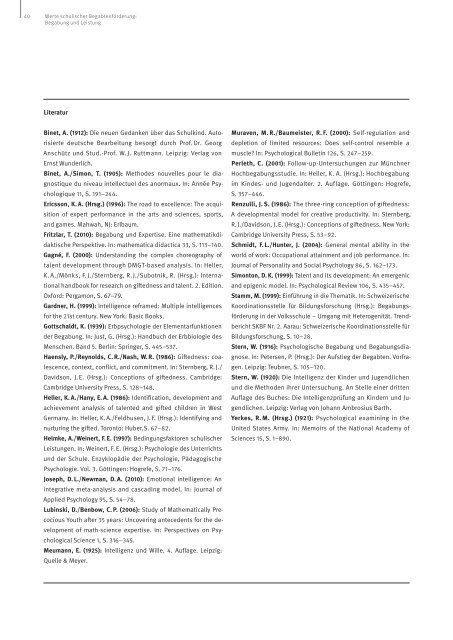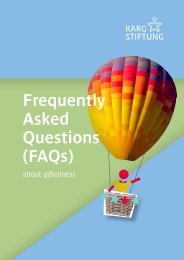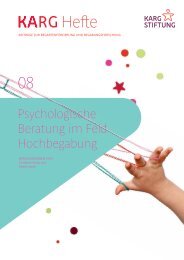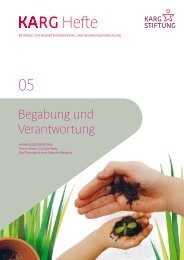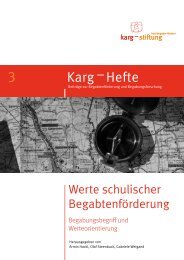Karg-Heft Nr. 4: Werte schulischer Begabtenförderung
Begabung und Leistung
Begabung und Leistung
Sie wollen auch ein ePaper? Erhöhen Sie die Reichweite Ihrer Titel.
YUMPU macht aus Druck-PDFs automatisch weboptimierte ePaper, die Google liebt.
40<br />
<strong>Werte</strong> <strong>schulischer</strong> <strong>Begabtenförderung</strong>:<br />
Begabung und Leistung<br />
Literatur<br />
Binet, A. (1912): Die neuen Gedanken über das Schulkind. Autorisierte<br />
deutsche Bearbeitung besorgt durch Prof. Dr. Georg<br />
Anschütz und Stud.-Prof. W. J. Ruttmann. Leipzig: Verlag von<br />
Ernst Wunderlich.<br />
Binet, A./Simon, T. (1905): Methodes nouvelles pour le diagnostique<br />
du niveau intellectuel des anormaux. In: Année Psychologique<br />
11, S. 191–244.<br />
Ericsson, K. A. (Hrsg.) (1996): The road to excellence: The acquisition<br />
of expert performance in the arts and sciences, sports,<br />
and games. Mahwah, NJ: Erlbaum.<br />
Fritzlar, T. (2010): Begabung und Expertise. Eine mathematikdidaktische<br />
Perspektive. In: mathematica didactica 33, S. 113–140.<br />
Gagné, F. (2000): Understanding the complex choreography of<br />
talent development through DMGT-based analysis. In: Heller,<br />
K. A./Mönks, F. J./Sternberg, R. J./Subotnik, R. (Hrsg.): International<br />
handbook for research on giftedness and talent. 2. Edition.<br />
Oxford: Pergamon, S. 67–79.<br />
Gardner, H. (1999): Intelligence reframed: Multiple intelligences<br />
for the 21st century. New York: Basic Books.<br />
Gottschaldt, K. (1939): Erbpsychologie der Elementarfunktionen<br />
der Begabung. In: Just, G. (Hrsg.): Handbuch der Erbbiologie des<br />
Menschen. Band 5. Berlin: Springer, S. 445–537.<br />
Haensly, P./Reynolds, C. R./Nash, W. R. (1986): Giftedness: coalescence,<br />
context, conflict, and commitment. In: Sternberg, R. J./<br />
Davidson, J. E. (Hrsg.): Conceptions of giftedness. Cambridge:<br />
Cambridge University Press, S. 128–148.<br />
Heller, K. A./Hany, E. A. (1986): Identification, development and<br />
achievement analysis of talented and gifted children in West<br />
Germany. In: Heller, K. A./Feldhusen, J. F. (Hrsg.): Identifying and<br />
nurturing the gifted. Toronto: Huber,S. 67–82.<br />
Helmke, A./Weinert, F. E. (1997): Bedingungsfaktoren <strong>schulischer</strong><br />
Leistungen. In: Weinert, F. E. (Hrsg.): Psychologie des Unterrichts<br />
und der Schule. Enzyklopädie der Psychologie, Pädagogische<br />
Psychologie. Vol. 3. Göttingen: Hogrefe, S. 71–176.<br />
Joseph, D. L./Newman, D. A. (2010): Emotional intelligence: An<br />
integrative meta-analysis and cascading model. In: Journal of<br />
Applied Psychology 95, S. 54–78.<br />
Lubinski, D./Benbow, C. P. (2006): Study of Mathematically Precocious<br />
Youth after 35 years: Uncovering antecedents for the development<br />
of math-science expertise. In: Perspectives on Psychological<br />
Science 1, S. 316–345.<br />
Meumann, E. (1925): Intelligenz und Wille. 4. Auflage. Leipzig:<br />
Quelle & Meyer.<br />
Muraven, M. R./Baumeister, R. F. (2000): Self-regulation and<br />
depletion of limited resources: Does self-control resemble a<br />
muscle? In: Psychological Bulletin 126, S. 247–259.<br />
Perleth, C. (2001): Follow-up-Untersuchungen zur Münchner<br />
Hochbegabungsstudie. In: Heller, K. A. (Hrsg.): Hochbega bung<br />
im Kindes- und Jugendalter. 2. Auflage. Göttingen: Hogrefe,<br />
S. 357–446.<br />
Renzulli, J. S. (1986): The three-ring conception of giftedness:<br />
A developmental model for creative productivity. In: Sternberg,<br />
R. J./Davidson, J. E. (Hrsg.): Conceptions of giftedness. New York:<br />
Cambridge University Press, S. 53–92.<br />
Schmidt, F. L./Hunter, J. (2004): General mental ability in the<br />
world of work: Occupational attainment and job performance. In:<br />
Journal of Personality and Social Psychology 86, S. 162–173.<br />
Simonton, D. K. (1999): Talent and its development: An emergenic<br />
and epigenic model. In: Psychological Review 106, S. 435–457.<br />
Stamm, M. (1999): Einführung in die Thematik. In: Schweizerische<br />
Koordinationsstelle für Bildungsforschung (Hrsg.): Begabungsförderung<br />
in der Volksschule – Umgang mit Heterogenität. Trendbericht<br />
SKBF <strong>Nr</strong>. 2. Aarau: Schweizerische Koordinationsstelle für<br />
Bildungsforschung, S. 10–28.<br />
Stern, W. (1916): Psychologische Begabung und Begabungsdiagnose.<br />
In: Petersen, P. (Hrsg.): Der Aufstieg der Begabten. Vorfragen.<br />
Leipzig: Teubner, S. 105–120.<br />
Stern, W. (1920): Die Intelligenz der Kinder und Jugendlichen<br />
und die Methoden ihrer Untersuchung. An Stelle einer dritten<br />
Auflage des Buches: Die Intelligenzprüfung an Kindern und Jugendlichen.<br />
Leipzig: Verlag von Johann Ambrosius Barth.<br />
Yerkes, R. M. (Hrsg.) (1921): Psychological examining in the<br />
United States Army. In: Memoirs of the National Academy of<br />
Sciences 15, S. 1–890.


